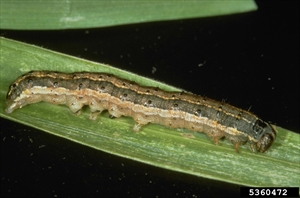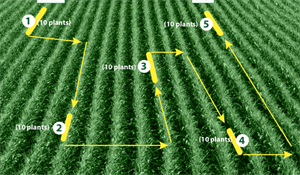- Widespread, and spreading. Present in Asia, but not Indonesia, the Philippines, Oceania. Hosts: maize, millets, rice, sorghum, sugarcane, and many others of economic importance.
- Damage: larvae eat leaves and bore into fruits, e.g., maize cobs. Crops losses across Africa since 2016 have cost billions of dollars.
- Eggs masses (up to 200) on underside of leaves. Young larvae green, feed together, later brown with three whitish lines along back, dark spots with spines, and upside-down Y on head. Larger larvae cannibalistic and nocturnal. Adults, brown forewings and white hindwings, up to 40 mm wingspan.
- Spread is rapid on the wing, and on air currents. Highly invasive.
- Natural enemies: many parasitoids and predators known, and pathogens.
- Cultural control: avoid overlapping crops; avoid planting new crops next to old; plant napier or Brachicaria grass (attracts moths) around crops, and Desmodium (repels moths) between crops; monitor; crush egg masses; bird perches; attract ants; ash for maize whorls; collect and burn debris after harvest,
- Chemical control: biorational pesticides: (i) botanicals (chillies, neem, derris, pyrethrum); (ii) microbials e.g., Bt (Bacillus thuringiensis subspecies kurstaki) against young caterpillars, spinosad, Beauveria; (iii) avoid other kinds of pesticides as moths have resistance to them, or will develop it, and (iv) will kill natural enemies.








